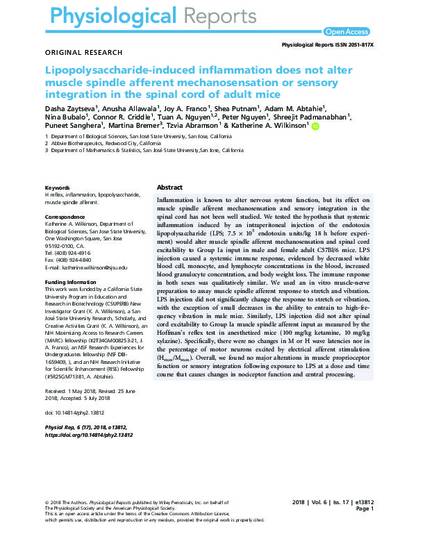
Article
Lipopolysaccharide‐induced inflammation does not alter muscle spindle afferent mechanosensation or sensory integration in the spinal cord of adult mice
Physiological Reports
(2018)
Abstract
Inflammation is known to alter nervous system function, but its effect on muscle spindle afferent mechanosensation and sensory integration in the spinal cord has not been well studied. We tested the hypothesis that systemic inflammation induced by an intraperitoneal injection of the endotoxin lipopolysaccharide (LPS; 7.5 × 105 endotoxin units/kg 18 h before experiment) would alter muscle spindle afferent mechanosensation and spinal cord excitability to Group Ia input in male and female adult C57Bl/6 mice. LPS injection caused a systemic immune response, evidenced by decreased white blood cell, monocyte, and lymphocyte concentrations in the blood, increased blood granulocyte concentration, and body weight loss. The immune response in both sexes was qualitatively similar. We used an in vitro muscle‐nerve preparation to assay muscle spindle afferent response to stretch and vibration. LPS injection did not significantly change the response to stretch or vibration, with the exception of small decreases in the ability to entrain to high‐frequency vibration in male mice. Similarly, LPS injection did not alter spinal cord excitability to Group Ia muscle spindle afferent input as measured by the Hoffman's reflex test in anesthetized mice (100 mg/kg ketamine, 10 mg/kg xylazine). Specifically, there were no changes in M or H wave latencies nor in the percentage of motor neurons excited by electrical afferent stimulation (Hmax/Mmax). Overall, we found no major alterations in muscle proprioceptor function or sensory integration following exposure to LPS at a dose and time course that causes changes in nociceptor function and central processing.
Keywords
- H reflex,
- inflammation,
- lipopolysaccharide,
- muscle spindle afferent
Disciplines
Publication Date
September 3, 2018
DOI
10.14814/phy2.13812
Publisher Statement
© 2018 The Authors. This article appears in Physiological Reports, volume 6, issue 17, 2018, published by Wiley Periodicals, Inc. on behalf of The Physiological Society and the American Physiological Society.
This is an open access article under the terms of the Creative Commons Attribution License, which permits use, distribution and reproduction in any medium, provided the original work is properly cited.
Citation Information
Dasha Zaytseva, Anusha Allawala, Joy A. Franco, Shea Putnam, et al.. "Lipopolysaccharide‐induced inflammation does not alter muscle spindle afferent mechanosensation or sensory integration in the spinal cord of adult mice" Physiological Reports Vol. 6 Iss. 17 (2018) ISSN: 2051-817X Available at: http://works.bepress.com/tzvia_abramson/21/
Creative Commons license

This work is licensed under a Creative Commons CC_BY International License.
